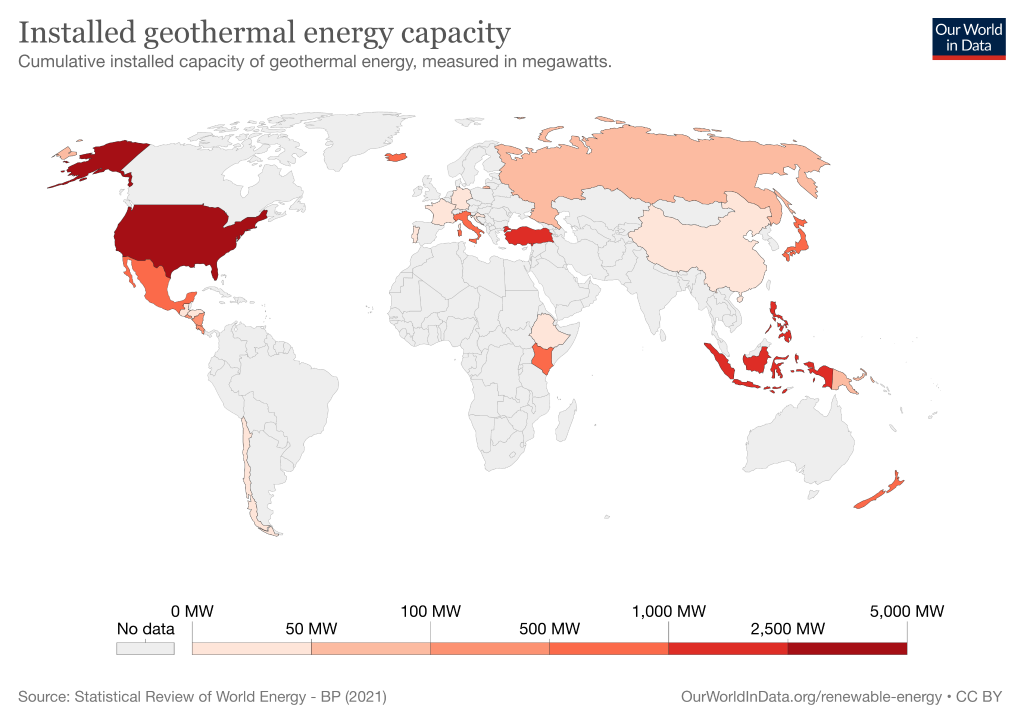What Is the Carbon Footprint of Geothermal Energy? A Life-Cycle Assessment
Impactful Ninja is reader-supported. When you buy through links on our site, we may earn an affiliate commission.
Learn more
Learn more
.
Hey fellow impactful ninja ? You may have noticed that Impactful Ninja is all about providing helpful information to make a positive impact on the world and society. And that we love to link back to where we found all the information for each of our posts. Most of these links are informational-based for you to check out their primary sources with one click. But some of these links are so-called "affiliate links" to products that we recommend. First and foremost, because we believe that they add value to you. For example, when we wrote a post about the environmental impact of long showers, we came across an EPA recommendation to use WaterSense showerheads. So we linked to where you can find them. Or, for many of our posts, we also link to our favorite books on that topic so that you can get a much more holistic overview than one single blog post could provide. And when there is an affiliate program for these products, we sign up for it. For example, as Amazon Associates, we earn from qualifying purchases. First, and most importantly, we still only recommend products that we believe add value for you. When you buy something through one of our affiliate links, we may earn a small commission - but at no additional costs to you. And when you buy something through a link that is not an affiliate link, we won’t receive any commission but we’ll still be happy to have helped you. When we find products that we believe add value to you and the seller has an affiliate program, we sign up for it. When you buy something through one of our affiliate links, we may earn a small commission (at no extra costs to you). And at this point in time, all money is reinvested in sharing the most helpful content with you. This includes all operating costs for running this site and the content creation itself. You may have noticed by the way Impactful Ninja is operated that money is not the driving factor behind it. It is a passion project of mine and I love to share helpful information with you to make a positive impact on the world and society. However, it's a project in that I invest a lot of time and also quite some money. Eventually, my dream is to one day turn this passion project into my full-time job and provide even more helpful information. But that's still a long time to go. Stay impactful,Affiliate Disclosure
Why do we add these product links?
What do these affiliate links mean for you?
What do these affiliate links mean for us?
What does this mean for me personally?
![]()
Geothermal energy is a sustainable energy source that uses heat from the earth’s core and produces little to no waste products while promising one of the lowest levels of carbon dioxide (CO2) emissions. So we had to ask: What is the carbon footprint of geothermal energy?
Geothermal energy has the sixth-lowest carbon footprint of all energy types. Per kWh produced, geothermal energy emits 38 grams of CO2 on a life-cycle basis. It combats climate change, comes with various environmental benefits, and has only minute amounts of greenhouse gas emissions.
Geothermal energy makes up an ever-growing amount of total energy consumption and has various environmental implications. Keep reading to learn about the overall carbon footprint of geothermal energy, its carbon footprint throughout its life-cycle, and its environmental impact.
How is Geothermal Energy Defined
The decay of radioactive materials in the rock and fluid of the earth’s core produces geothermal energy. Drilling down to hot water reservoirs up to a mile below the surface creates steam that rotates a turbine, which spins a generator to generate electricity. Geothermal is found along major tectonic plate boundaries where volcanoes are located. Because the Earth has an almost unlimited supply of heat generated by its core, and the water extracted from the reservoirs can be recycled via re-injection into the ground, it is a renewable energy source.
“Geothermal: involving or produced by the heat that is inside the earth”
Cambridge Dictionary
The three main types of geothermal power plants are:
- Dry Steam: Wells are drilled into underground reservoirs of steam. The steam is piped directly from the well to the power plant where it powers turbines and generators.
- Flash Steam: The most common type of geothermal power plant. Very hot (360 degrees Fahrenheit, 182 degrees Celsius) water flows up through wells towards the surface under its own pressure. As it reaches the surface, some of the water boils into steam. The steam is then separated from the water and is then used to power turbines and generators at the power plant.
- Binary Steam: Wells are drilled into underground reservoirs of hot water (225-360 degrees Fahrenheit, 107-182 degrees Celsius). The heat from the water is used to boil a working fluid, an organic compound with a low boiling point. This working fluid is vaporized into steam which is then used to power turbines and generators at the power plant. The water is then injected back into the ground where it is reheated and can be used again. There are virtually no air emissions during this process because the working fluid and water are kept separate during the process.
All three types of geothermal power plants harvest water from the earth’s core in the same manner, by drilling down to reservoirs and extracting the hot water to produce steam, turn turbines, and power generators to create electricity.
What is the Carbon Footprint of Geothermal Energy
The carbon footprint is one of the ways we measure the effects of human-induced global climate change. It primarily focuses on the greenhouse gas (GHG) emissions associated with consumption and includes other emissions such as methane (CH4), nitrous oxide, and chlorofluorocarbons (CFCs).
“Carbon footprint: the amount of greenhouse gases and specifically carbon dioxide emitted by something (such as a person’s activities or a product’s manufacture and transport) during a given period”
Merriam Webster
Basically, it is the amount of carbon emitted by an activity or an organization. This includes GHG emissions from fuel that we burn directly (e.g., heating a home, driving a car) and GHG emissions from manufacturing the products that we use (e.g., power plants, factories, and landfills).
What Is the Overall Carbon Footprint of Geothermal Energy
On a life-cycle basis, geothermal energy emits 38 grams of CO2 equivalent per kWh of electricity produced, the 6th lowest out of all fuel types.

The United States (US) is a leader in geothermal energy production. However, it still only produced 0.4% of its total electricity from geothermal in 2020.

The six largest geothermal energy-producing countries (amount per year) in the world are:
- US – 3,639 megawatts (MW)
- Indonesia – 1,948 MW
- Philippines – 1,868 MW
- Turkey – 1,347 MW
- New Zealand – 1,005 MW
- Mexico – 951 MW
The potential electricity generation for geothermal is 240 GW, with lower and upper limits of 50 GW and 1000-2000 GW, respectively. Geothermal energy accounted for 0.3% of global electricity generation in 2016, with an installed capacity of 12.7 gigawatts (GW) producing 80.9 terawatt-hours (TWh). By 2021, the global geothermal industry is expected to reach approximately 18.4 GW.
Because geothermal energy has a large electricity generation potential – and production has steadily increased in the last decade – it is important to understand what its carbon footprint is. And how its carbon emissions affect the global climate change process.
To understand the carbon footprint of geothermal energy, we must assess its life cycle and each stage’s carbon footprint. This life-cycle assessment (LCA) is a method to evaluate the environmental impacts of products and materials. Over the years, companies have strategically used LCA to research and create more sustainable products. So, let’s have a look at the LCA of geothermal energy!
| The life-cycle stages of geothermal energy | Each stage’s carbon footprint |
| Building of geothermal energy | CO2 emissions from drilling geothermal wells and construction of geothermal power plants |
| Operating of geothermal energy | CO2 emissions from the operation of geothermal power plants |
| Building back of geothermal energy | Little to no CO2 emissions or waste products |
The total carbon footprint of geothermal energy would equal the carbon footprint from building + the carbon footprint from operating + the carbon footprint from building back.
What Is the Carbon Footprint of Building Geothermal Energy
The carbon footprint of building geothermal energy includes drilling the geothermal wells and constructing the power plant.
Geothermal well drilling involves the following:
- Preparing the rig site
- Drilling
- Cementing and testing
- Well completion
- Production
- Well abandonment and land restoration
Depending on the type of geothermal power plant, many components may be required, and building these components requires machinery that emits CO2. The wells, condensers, generators, and turbines are all components with a carbon footprint.
CO2 emissions at this stage occur when drilling the wells and when utilizing the construction equipment to build the power plant.
What Is the Carbon Footprint of Operating Geothermal Energy
Geothermal power plants operate in the following way:
- Wells are drilled into the Earth’s surface to expose hot water reservoirs
- The water is pumped to the earth’s surface
- The hot gases and heat energy convert water into steam
- The steam is then passed into a turbine where it rotates the blades at a high speed.
- The blades then turn a generator which generates the electricity
- Once the steam passes through the turbine it is condensed back into water and returned to the boiler chamber to be reheated
Geothermal power plants do release minute amounts of CO2, nitrogen oxides, and particulate matter, but not during combustion. These gases are naturally occurring in geothermal reservoirs and would eventually vent to the surface and into the atmosphere, albeit at much slower rates.
There are very few CO2 emissions or waste products associated with operating geothermal energy, making the carbon footprint of this phase very low. CO2 emissions at this stage are associated with the operation of the mechanical equipment (e.g., turbines and generators) at the power plant.
What Is the Carbon Footprint of Building Back Geothermal Energy
Building back geothermal energy involves decommissioning the wells and deconstructing the power plant infrastructure.
Geothermal heat pumps can last more than 20 years, and the underground infrastructure has a historical life expectancy of up to 50 years. This makes them a long-term, reliable source of energy.
CO2 emissions at this final stage occur when utilizing construction equipment to demolish the buildings and construct new buildings in the old power plant’s place.
What Role Does Geothermal Energy Play in Combating Climate Change
Fossil fuel combustion is the main contributor to atmospheric CO2 levels. Climate Change occurs when CO2 and other air pollutants absorb sunlight and solar radiation in the atmosphere, trapping the heat and acting as an insulator for the planet. Since the Industrial Revolution, Earth’s temperature has risen a little more than 1 degree Celsius (C), or 2 degrees Fahrenheit (F). The current global annual temperature rise is 0.18C, or 0.32F, for every 10 years.
Using geothermal energy instead of fossil fuel energy helps mitigate the following negative effects of climate change:
- Increasing temperatures: Earth’s atmosphere has warmed 1.5℃ since 1880. This may not seem like a lot, but these degrees create regional and seasonal temperature extremes, reduce sea ice, intensify rainfall and drought severity, and change habitat ranges for plants and animals.
- Rising sea levels: Global sea levels have increased approximately 8-9 inches since 1880, displacing people living along coastlines and destroying coastal habitats. Roads, bridges, subways, water supplies, oil and gas wells, power plants, sewage treatment plants, and landfills remain at risk if sea level rise goes unchecked.
- Melting of sea ice: Since 1979, arctic sea ice has declined by 30%. Sea ice plays a major role in regulating the earth’s climate by reflecting sunlight into space and providing habitat for animal species. If all of the glaciers on Earth melted, sea levels would rise by approximately 70 feet, effectively flooding out every coastal city on the planet.
- Changing precipitation patterns: Extreme weather events (e.g., hurricanes, floods, droughts) are becoming more common and more intense. Storm-affected areas will experience increased precipitation and flooding whereas areas located further from storm tracks will experience decreased precipitation and droughts.
- Ocean Acidification: The ocean absorbs 30% of the CO2 released into the atmosphere, which decreases the pH (increases the acidity) of the ocean. In the past 200 years, the pH of oceans has decreased by 0.1 pH units, which translates to a 30% increase in acidity. Aquatic life unable to adjust to this rapid acidification will die off. A prime example of this is coral bleaching, where coral expel the algae (zooxanthellae) living in their tissues as a result of changes in temperature, light, or nutrients.
Experts claim that to avoid a future plagued by rising sea levels, acidified oceans, loss of biodiversity, more frequent and severe weather events, and other environmental disasters brought on by the hotter temperatures, we must limit global warming to 1.5C by 2040.
The more we reduce CO2 emissions, the more we slow the rate of temperature rise, sea-level rise, ice melting, and ocean acidification. When these rates are slowed, the earth’s biodiversity does not have to struggle to adapt to temperature and pH changes. People will not be displaced due to the flooding of coastal areas. And icebergs will continue to provide climate regulation.
How Environmentally Friendly Is Geothermal Energy
The environmental impacts of geothermal energy depend on how the energy is used and how it is converted to useful energy.
“Environmentally friendly: (of products) not harming the environment.”
Cambridge Dictionary
Overall, geothermal energy is environmentally friendly because it is a renewable energy source that releases minute amounts of CO2.
What Are Environmental Benefits of Geothermal Energy
Here are the ways in which geothermal energy benefits the environment:
- Protects Air Quality: Rather than combusting materials, naturally occurring hot water creates steam which spins turbines to generate electricity. Geothermal power plants produce a minute amount of greenhouse gases, emitting 99% less CO2 than fossil fuel plants of comparable size. Dry and flash steam plants emit mostly water vapor whereas binary steam plants emit virtually no gases at all because they operate under a closed-loop system. All three systems also produce very low amounts of sulfur dioxide and no nitrogen oxides. Scrubbers remove 99.9% of sulfur emissions when utilized.
- Minimal Land Use Impact: Compared to fossil fuel power plants, geothermal energy has a small environmental footprint. Geothermal plants only require 1-8 acres of land per MW whereas 5-10 and 19 acres are required per MW for nuclear and coal, respectively. Drilling wells can impact the land, but directional drilling, drilling several wells from a single location, reduces the amount of land required. Likewise, slimhole wells can be drilled which are only 4-6” in diameter compared to traditional wells at 8-12”.
- Few Waste Products: Most geothermal plants do not create measurable solid waste byproducts.
- Climate Change Mitigation: Geothermal energy has an average life-cycle CO2 equivalent emission value that is much less than coal, 38g of CO2 equivalent per kWh compared to 820g of CO2 equivalent per kWh, respectively. This reduction in CO2 emissions, in turn, reduces the effects of global climate change including increasing temperatures, rising sea levels, melting of sea ice, changing precipitation patterns, and ocean acidification.
- Energy Independence: Being able to produce our own electricity in the U.S. without the aid of foreign countries is an important step to help us become more self-sufficient. Former President George W. Bush signed the Energy Independence and Security Act of 2007 to reduce U.S. dependence on oil, expand the production of renewable fuels (and confront global climate change).
- Employment Opportunities: Geothermal supported approximately 100,000 jobs in 2019, most of which were in the European Union. And this number has likely increased because the renewable energy sector collectively employed 11.5 million people worldwide in 2019. Renewable energy jobs continue to increase as we start to realize just how beneficial renewable energy is for our environment.
Throughout its life cycle, geothermal energy produces 5% of the CO2 emissions per unit of electricity that coal produces. In the US alone, annual geothermal energy resources effectively offset the emission of 4.1 million metric tons (t) of CO2, 200,000 t of SO2, 80,000 t of nitrogen oxides, and 110,000 t of particulate matter when compared to conventional coal-fired plants.
What Are Environmental Drawbacks of Geothermal Energy
Because geothermal energy is a relatively clean energy source, there are few environmental drawbacks. These can include:
- Location Specificity: Geothermal reservoirs occur deep underground and are not detectable from the surface. Areas where geothermal does come to the surface include volcanoes, fumaroles, hot springs, and geysers. These are only found near tectonic plate boundaries. The largest area of harvestable geothermal energy can be found at the Ring of Fire, which lines the edges of the Pacific Ocean. The most notable areas in the US for geothermal include the western US (California, Nevada, Arizona, New Mexico) and Hawaii.
- Earthquakes: High-pressure fluid injections close to neighboring fault lines have the potential to trigger earthquakes. In 2017, a 5.4 magnitude earthquake struck Pohang, South Korea, as a result of an experimental geothermal power plant. It injured 135 people and caused roughly $290 million in damages. Also, 90% of all earthquakes occur in the Ring of Fire, an area that coincides with the highest concentration of geothermal resources.
Negative environmental impacts can be minimized by directional drilling, siting power plants away from major fault lines, properly disposing of hazardous waste captured by the scrubbers, and recycling the geothermal steam and water via re-injection into the ground.
Final Thoughts
Geothermal energy is a sustainable energy source with a low carbon footprint across its building, operating, and building back phases. Using heat from the earth’s core produces little to no GHG emissions or waste products. It benefits the environment by combating climate change, creating jobs, and promoting energy independence. Any environmental drawbacks can be minimized with proper planning of projects and siting of wells.
Stay impactful,

Sources
- TWI: What is Geothermal Energy? How Does it Work?
- National Renewable Energy Laboratory: Geothermal Electricity Production Basics
- Britannica: Carbon Footprint
- United States Environmental Protection Agency: System of Registries
- World Nuclear Association: Carbon Emissions from Electricity
- US Energy Information Administration: Use of Geothermal Energy
- Our World in Data: Installed Geothermal Capacity
- NS Energy: Profiling the top geothermal power producing countries in the world
- International Renewable Energy Agency: Geothermal Power – Technology Brief
- Statista: Global geothermal energy capacity from 2009 to 2020
- Science Direct: Life-cycle assessment (LCA)
- MIT SMR: Strategic Sustainability Uses of Life-Cycle Analysis
- Office of Energy Efficiency and Renewable Energy: Handbook of Best Practices for Geothermal Drilling
- Energy Education: Geothermal Power Plants
- Office of Energy Efficiency & Renewable Energy: Geothermal Power Plants — Meeting Clean Air Standards
- Resources for the Future: Geothermal Energy 101
- Union of Concerned Scientists: The Hidden Costs of Fossil Fuels
- National Resources Defense Council: Global Warming 101
- The National Wildlife Federation: Climate Change
- National Oceanic and Atmospheric Administration: Climate Change – Global Temperature
- National Oceanic and Atmospheric Administration: Climate Change – Global Sea Level
- United States Geological Survey: How would sea level change if all glaciers melted?
- National Aeronautics and Space Administration, U.S.A.: How does climate change affect precipitation?
- National Oceanic and Atmospheric Administration: Ocean Acidification
- National Ocean Service: What is coral bleaching?
- United Nations Framework Convention on Climate Change: The Paris Agreement
- Office of Energy Efficiency & Renewable Energy: Geothermal FAQs
- National Renewable Energy Laboratory: Buried Treasure – The Environmental, Economic, and Employment Benefits of Geothermal Energy
- US Energy Information Administration: Geothermal Energy and the Environment
- Office of Energy Efficiency & Renewable Energy: Electricity Generation
- White House Archives: Fact Sheet – Energy Independence and Security Act of 2007
- United States Environmental Protection Agency: Summary of the Energy Independence and Security Act
- International Renewable Energy Agency: Renewable Energy Jobs Continue Growth to 11.5 Million Worldwide
- Statista: Geothermal energy: related jobs worldwide by region 2019
- US Energy Information Administration: Geothermal explained – Where geothermal energy is found
- United States Geological Survey: EarthWord – Fumarole
- United States Geological Survey: Earthquake Glossary – Ring of Fire
- Nature: South Korea accepts geothermal plant probably caused destructive quake
- Britannica: Geothermal Energy – Environmental Effects and Economic Costs




